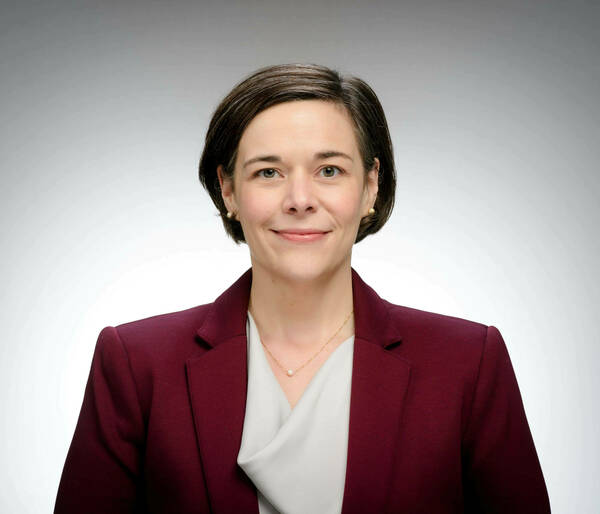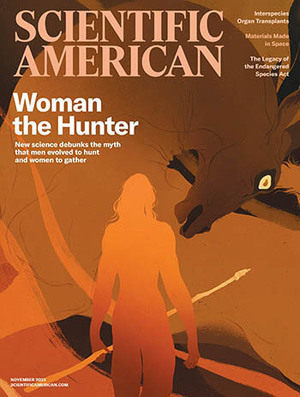‘Woman the hunter’: Studies aim to correct history

When Cara Ocobock was a young child, she often wondered at the images in movies, books, comics and cartoons portraying prehistoric men and women as such: “man the hunter” with spear in hand, accompanied by “woman the gatherer” with a baby strapped to her back and a basket of crop seeds in hand.
“This was what everyone was used to seeing,” Ocobock said. “This was the assumption that we’ve all just had in our minds and that was carried through in our museums of natural history.”
Many years later, Ocobock, an assistant professor in the Department of Anthropology and director of the Human Energetics Laboratory at the University of Notre Dame, found herself as a human biologist studying physiology and prehistoric evidence and discovering that many of these conceptions about early women and men weren’t quite accurate. The accepted reconstruction of human evolution assumed males were biologically superior, but that interpretation wasn’t telling the whole story.
Relying on both physiological and archaeological evidence, Ocobock and her research partner, Sarah Lacy, an anthropologist with expertise in biological archaeology at the University of Delaware, recently published two studies simultaneously in the journal American Anthropologist. Their joint research, coming from these two angles, found that not only did prehistoric women engage in the practice of hunting, but their female anatomy and biology would have made them intrinsically better suited for it.
 Cover art courtesy of Samantha Mash
Cover art courtesy of Samantha MashOf her and her co-author’s dual-pronged research, which was the cover story for the November issue of Scientific American, Ocobock said, “Rather than viewing it as a way of erasing or rewriting history, our studies are trying to correct the history that erased women from it.”
Female physiology and estrogen, the ‘unsung hero of life’
In their physiological study, the two researchers explained that prehistoric females were quite capable of performing the arduous physical task of hunting prey and were likely able to hunt successfully over prolonged periods of time. From a metabolic standpoint, Ocobock explained, the female body is better suited for endurance activity, “which would have been critical in early hunting because they would have had to run the animals down into exhaustion before actually going in for the kill.”
Two huge contributors to that enhanced metabolism are hormones — in this case, estrogen and adiponectin, which are typically present in higher quantities in female bodies than in male. These two hormones play a critical role in enabling the female body to modulate glucose and fat, a function that is key in athletic performance.
Estrogen, in particular, helps regulate fat metabolism by encouraging the body to use its stored fat for energy before using up its carbohydrate stores. “Since fat contains more calories than carbs do, it’s a longer, slower burn,” Ocobock explained, “which means that the same sustained energy can keep you going longer and can delay fatigue.”
Estrogen also protects the body’s cells from damage during heat exposure due to extreme physical activity. “Estrogen is really the unsung hero of life, in my mind,” Ocobock said. “It is so important for cardiovascular and metabolic health, brain development and injury recovery.”
Adiponectin also amplifies fat metabolism while sparing carbohydrate and/or protein metabolism, allowing the body to stay the course during extended periods, especially over great distances. In this way, adiponectin is able to protect the muscles from breaking down and keeps them in better condition for sustained exercise, Ocobock explained.
The female body structure itself is another element Ocobock and Lacy found to be of advantage in terms of endurance and effectiveness for prehistoric hunters. “With the typically wider hip structure of the female, they are able to rotate their hips, lengthening their steps,” Ocobock detailed. “The longer steps you can take, the ‘cheaper’ they are metabolically, and the farther you can get, faster.
“When you look at human physiology this way, you can think of women as the marathon runners versus men as the powerlifters.”
Archaeology tells more of the story of ‘woman the hunter’
Several archaeological findings indicate prehistoric women not only shared in the resulting injuries of the dangerous business of close-contact hunting, but that it was an activity held in high esteem and valued by them. “We have constructed Neandertal hunting as an up-close-and-personal style of hunting,” Ocobock said, “meaning that hunters would often have to get up underneath their prey in order to kill them. As such, we find that both males and females have the same resulting injuries when we look at their fossil records.”
Ocobock described those traumatic injuries as being similar to those received by modern-day rodeo clowns — injuries to the head and chest where they were kicked by the animal, or to the limbs where they were bitten or received a fracture. “We find these patterns and rates of wear and tear equally in both women and men,” she said. “So they were both participating in ambush-style hunting of large game animals.”
Second, Ocobock said, there is evidence of early female hunters in the Holocene period in Peru where females were buried with hunting weapons. “You don’t often get buried with something unless it was important to you or was something that you used frequently in your life.
“Furthermore, we have no reason to believe that prehistoric women abandoned their hunting while pregnant, breastfeeding or carrying children,” Ocobock added, “nor do we see in the deep past any indication that a strict sexual division of labor existed.”
The bottom line, Ocobock noted, was that “hunting belonged to everyone, not just to males,” especially in prehistoric societies where survival was an all-hands-on-deck activity. “There weren’t enough people living in groups to be specialized in different tasks. Everyone had to be a generalist to survive.”
Fighting bias
“This revelation is especially important in the current political moment of our society where sex and gender are in a spotlight,” Ocobock said. “And I want people to be able to change these ideas of female physical inferiority that have been around for so long.”
When talking about reconstructing the past in order to better understand it — and to conduct “good science” — Ocobock said scientists have to be extremely careful about how modern-day bias can seep into one’s interpretations of the past. She cautioned that researchers have to be aware of their own biases and make sure they are asking the proper questions so the questions don’t lead them down the road of looking for what it is they want to see.
“We have to change the biases we bring to the table, or at least to give pause before we assign those biases. And in a broader sense, you cannot outrightly assume somebody’s abilities based on whatever sex or gender you have assigned by looking at them,” Ocobock concluded.
Contact: Tracy DeStazio, associate director of media relations, 574-631-9958 or tdestazi@nd.edu
Latest Faculty & Staff
- In new research, Roy Scranton explores climate change and the limits of human progressIn his most recent book, “Impasse: Climate Change and the Limits of Progress,” Scranton, an associate professor of English, defines the impasse he sees as “not only political and institutional, but cognitive, existential and narrative” and asserts that the only path forward is through embracing what he terms ethical pessimism. “A lot of people confuse pessimism with nihilism, apathy and despair,” Scranton said. “But pessimism is actually about recognizing our limits, letting go of unrealistic goals, finding solidarity in the fact of human suffering and doing what you can now, not in some utopian future.
- Joule Bergerson, energy technology assessment expert, named new director of ND EnergyND Energy faculty director Joule…
- In memoriam: Alasdair MacIntyre, the Rev. John A. O’Brien senior research professor of philosophy emeritusAlasdair MacIntyre, the Rev. John A. O’Brien senior research professor of philosophy emeritus and a permanent senior distinguished research fellow at the de Nicola Center for Ethics and Culture, died on May 21, 2025. He was 96.
- Santiago Schnell, dean of Notre Dame’s College of Science, appointed as provost of DartmouthSantiago Schnell, the William K. Warren Foundation Dean of the College of Science at the University of Notre Dame, has accepted an appointment as provost at Dartmouth College. He will depart Notre Dame at the end of June and begin his new role in July.
- Notre Dame’s Fightin’ Irish Battalion receives Department of Defense award as nation’s top Army ROTC programThe United States Department of Defense honored the University of Notre Dame’s Army ROTC Fightin’ Irish Battalion as the nation’s top Army collegiate program for the 2023-24 academic year. This will be the first time the unit has received the department’s Educational Institution Partnership Excellence Award, which recognizes the program’s achievements in recruiting, educating, training and commissioning leaders of character to be the next generation of military officers.
- In memoriam: Karl Ameriks, the McMahon-Hank Professor of Philosophy EmeritusKarl Ameriks, the McMahon-Hank Professor of Philosophy Emeritus at the University of Notre Dame, died on April 28 from pancreatic cancer. He was 77. Born in post-World War II Germany, Ameriks’ family emigrated to the United States when he was a child, and he grew up in Detroit, Michigan. He received his bachelor’s and doctoral degrees from Yale University. He came to the Department of Philosophy at Notre Dame in 1973 during a formative time for the department, which had transitioned from a predominantly Thomist focus to the more analytical American philosophy in the 1960s.











